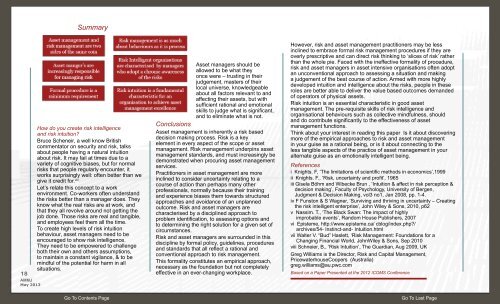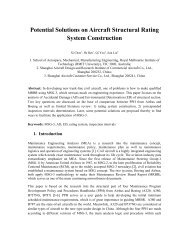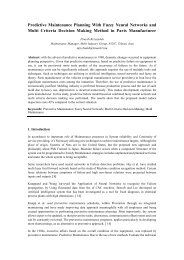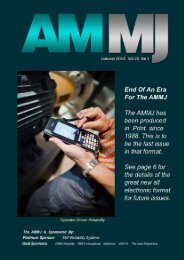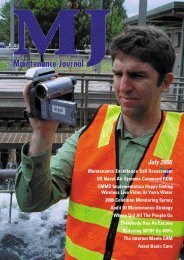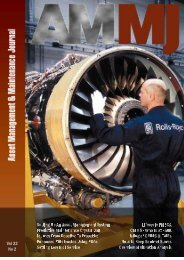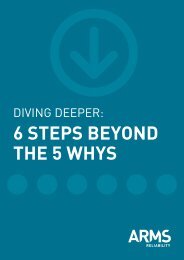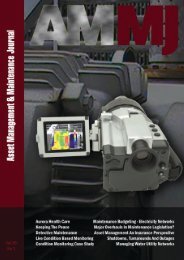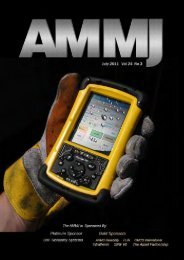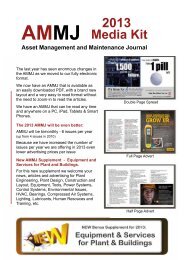Maintenance & Reliability News - Maintenance Journal
Maintenance & Reliability News - Maintenance Journal
Maintenance & Reliability News - Maintenance Journal
Create successful ePaper yourself
Turn your PDF publications into a flip-book with our unique Google optimized e-Paper software.
Summary<br />
18<br />
AMMJ<br />
May 2013<br />
How do you create risk intelligence<br />
and risk intuition?<br />
Bruce Scheneir, a well know British<br />
commentator on security and risk, talks<br />
about people having a natural intuition<br />
about risk. It may fail at times due to a<br />
variety of cognitive biases, but for normal<br />
risks that people regularly encounter, it<br />
works surprisingly well: often better than we<br />
give it credit for. viii<br />
Let’s relate this concept to a work<br />
environment. Co-workers often understand<br />
the risks better than a manager does. They<br />
know what the real risks are at work, and<br />
that they all revolve around not getting the<br />
job done. Those risks are real and tangible,<br />
and employees feel them all the time.<br />
To create high levels of risk intuition<br />
behaviour, asset managers need to be<br />
encouraged to show risk intelligence.<br />
They need to be empowered to challenge<br />
both their own and others assumptions,<br />
to maintain a constant vigilance, & to be<br />
mindful of the potential for harm in all<br />
situations.<br />
Asset managers should be<br />
allowed to be what they<br />
once were – trusting in their<br />
judgement, masters of their<br />
local universe, knowledgeable<br />
about all factors relevant to and<br />
affecting their assets, but with<br />
sufficient rational and emotional<br />
skills to judge what is significant,<br />
and to eliminate what is not.<br />
Conclusions<br />
Asset management is inherently a risk based<br />
decision making process. Risk is a key<br />
element in every aspect of the scope or asset<br />
management. Risk management underpins asset<br />
management standards, and must increasingly be<br />
demonstrated when procuring asset management<br />
services.<br />
Practitioners in asset management are more<br />
inclined to consider uncertainty relating to a<br />
course of action than perhaps many other<br />
professionals, normally because their training<br />
and experience biases them towards structured<br />
approaches and avoidance of an unplanned<br />
outcome. Risk and asset managers are<br />
characterised by a disciplined approach to<br />
problem identification, to assessing options and<br />
to determining the right solution for a given set of<br />
circumstances.<br />
Risk and asset managers are surrounded in this<br />
discipline by formal policy, guidelines, procedures<br />
and standards that all reflect a rational and<br />
conventional approach to risk management.<br />
This formality constitutes an empirical approach,<br />
necessary as the foundation but not completely<br />
effective in an ever-changing workplace.<br />
However, risk and asset management practitioners may be less<br />
inclined to embrace formal risk management procedures if they are<br />
overly prescriptive and can direct risk thinking to ‘slices of risk’ rather<br />
than the whole pie. Faced with the ineffective formality of procedure,<br />
risk and asset managers in asset intensive organisations often adopt<br />
an unconventional approach to assessing a situation and making<br />
a judgement of the best course of action. Armed with more highly<br />
developed intuition and intelligence about the risks, people in these<br />
roles are better able to deliver the value based outcomes demanded<br />
of operators of physical assets.<br />
Risk intuition is an essential characteristic in good asset<br />
management. The pre-requisite skills of risk intelligence and<br />
organisational behaviours such as collective mindfulness, should<br />
and do contribute significantly to the effectiveness of asset<br />
management functions.<br />
Think about your interest in reading this paper Is it about discovering<br />
more of the empirical approaches to risk and asset management<br />
in your guise as a rational being, or is it about connecting to the<br />
less tangible aspects of the practice of asset management in your<br />
alternate guise as an emotionally intelligent being.<br />
References<br />
i Knights. F, ‘The limitations of scientific methods in economics’,1999<br />
ii Knights. F., ‘Risk, uncertainty and profit’, 1965<br />
iii Gisela Böhm and Wibecke Brun , ‘Intuition & affect in risk perception &<br />
decision making’, Faculty of Psychology, University of Bergen,<br />
Judgment & Decision Making, vol3 no1, Jan 2008, pp. 1-4.<br />
iv F Funston & S Wagner, ‘Surviving and thriving in uncertainty – Creating<br />
the risk intelligent enterprise’, John Wiley & Sons, 2010, p62<br />
v Nassim. T., ‘The Black Swan: The impact of highly<br />
improbable events’, Random House Publishers, 2007<br />
vi Episteme, http://www.episteme.ca/ cblog/index.php?/<br />
archives/54- Instinct-and- Intuition.html<br />
vii Walter V. “Bud” Haslett, ‘Risk Management: Foundations for a<br />
Changing Financial World, JohnWiley & Sons, Sep 2010<br />
viii Schneier, B., ‘Risk Intuition’, The Guardian, Aug 2009, UK<br />
Greg Williams is the Director, Risk and Capital Management,<br />
PricewaterhouseCoopers (Australia)<br />
greg.williams@au.pwc.com<br />
Based on a Paper Presented at the 2012 ICOMS Conference<br />
Go To Contents Page<br />
Go To Last Page


